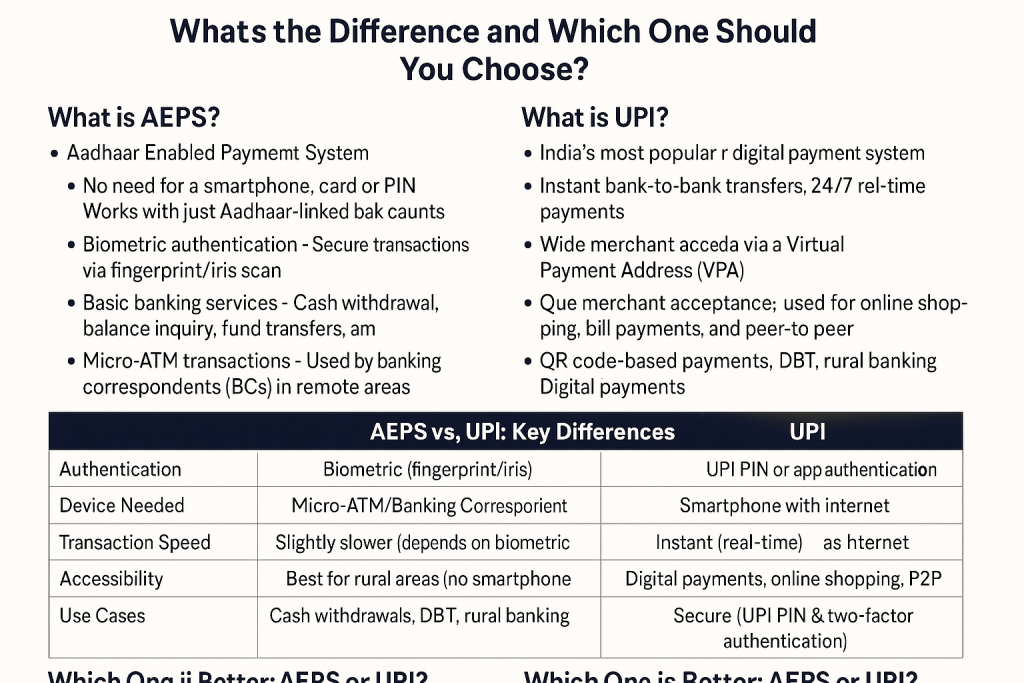In today’s digital age, banking and payments have become faster and more convenient thanks to systems like AEPS (Aadhaar Enabled Payment System) and UPI (Unified Payments Interface). Both are widely used in India, but they serve different purposes and operate in distinct ways.
If you’re wondering what is the difference between AEPS and UPI, and which one is better for your needs, this guide will break it all down. We’ll compare their features, security, ease of use, and ideal use cases so you can make an informed choice.

What is AEPS?
AEPS (Aadhaar Enabled Payment System) is a bank-led payment model that allows transactions using just an Aadhaar number and biometric authentication (fingerprint/iris scan). Introduced by the National Payments Corporation of India (NPCI), AEPS primarily targets rural and semi-urban populations with limited access to smartphones or debit cards.
Key Features of AEPS:
-
No need for a smartphone, card, or PIN – Works with just Aadhaar-linked bank accounts.
-
Biometric authentication – Secure transactions via fingerprint/iris scan.
-
Basic banking services – Cash withdrawal, balance inquiry, fund transfers, and more.
-
Micro-ATM transactions – Used by banking correspondents (BCs) in remote areas.
Where is AEPS Used?
-
Rural banking (where internet access is limited).
-
Government subsidy disbursements (like DBT – Direct Benefit Transfer).
-
Small merchants and banking correspondents.
What is UPI?
UPI (Unified Payments Interface) is India’s most popular digital payment system, enabling instant money transfers using a smartphone. Developed by NPCI, UPI allows users to link multiple bank accounts to a single mobile app (like Google Pay, PhonePe, or Paytm) and make seamless transactions.
Key Features of UPI:
-
Instant bank-to-bank transfers – 24/7 real-time payments.
-
No physical card needed – Works via a Virtual Payment Address (VPA).
-
Wide merchant acceptance – Used for online shopping, bill payments, and peer-to-peer (P2P) transfers.
-
QR code-based payments – Scan and pay at stores without cash.
Where is UPI Used?
-
Online shopping and e-commerce.
-
Peer-to-peer (P2P) payments (splitting bills, sending money to family).
-
Bill payments, recharges, and subscriptions.
AEPS vs. UPI: Key Differences
| Feature | AEPS | UPI |
|---|---|---|
| Authentication | Biometric (fingerprint/iris) | UPI PIN or app authentication |
| Device Needed | Micro-ATM/Banking Correspondent | Smartphone with internet |
| Transaction Speed | Slightly slower (depends on biometric verification) | Instant (real-time) |
| Accessibility | Best for rural areas (no smartphone needed) | Requires smartphone & internet |
| Use Cases | Cash withdrawals, DBT, rural banking | Digital payments, online shopping, P2P transfers |
| Security | High (biometric verification) | Secure (UPI PIN & two-factor authentication) |

Which One is Better: AEPS or UPI?
The better choice between AEPS and UPI depends on your needs:
Choose AEPS If You…
-
Live in a rural area with limited internet access.
-
Need cash withdrawals without a debit card.
-
Receive government subsidies (DBT) via Aadhaar-linked accounts.
Choose UPI If You…
-
Have a smartphone and internet access.
-
Prefer fast, cashless transactions.
-
Frequently shop online or transfer money digitally.
Final Verdict:
-
UPI is better for urban users who want quick, cashless payments.
-
AEPS is essential for rural banking where smartphones and cards are less common.
Frequently Asked Questions (FAQs)
1. Can I use AEPS without Aadhaar?
No, AEPS requires Aadhaar-linked biometric authentication.
2. Is UPI safer than AEPS?
Both are secure, but UPI uses a PIN, while AEPS relies on biometrics.
3. Which has lower transaction fees?
UPI is mostly free for P2P transfers, while AEPS may have small charges at micro-ATMs.
4. Can I use UPI without a bank account?
No, UPI requires a linked bank account, whereas AEPS works with Aadhaar-linked accounts.
5. Which is more widely accepted?
UPI is accepted at most online and offline merchants, while AEPS is mainly for basic banking services.
Conclusion
Both AEPS and UPI have transformed digital payments in India, but they cater to different audiences. UPI is the go-to for tech-savvy users who prefer instant digital transactions, while AEPS bridges the gap for rural and unbanked populations by enabling cashless banking without smartphones.
Your choice depends on your location, banking needs, and access to technology. If you’re in an urban area, UPI is the best option, but if you need cash-based transactions in remote areas, AEPS is invaluable.
Disclaimer
This post is for educational purposes only. If you have any concerns regarding this content, please visit our DMCA page for removal requests. Always verify ownership or legal issues related to the information provided.
